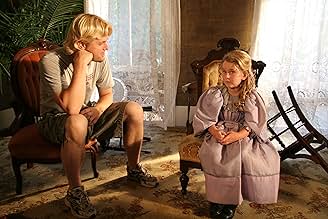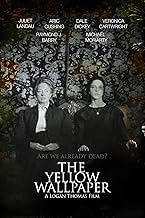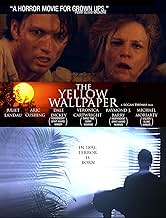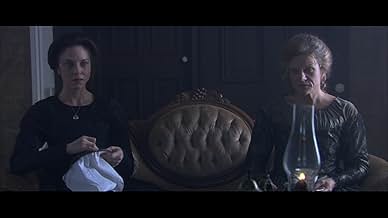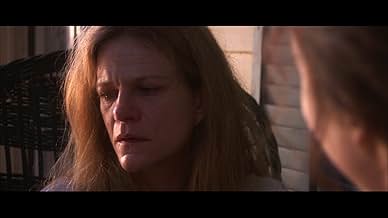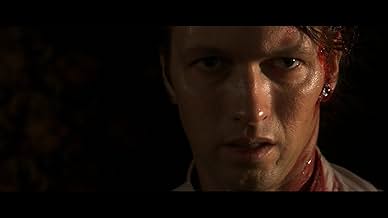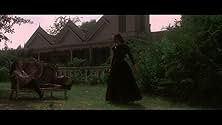AVALIAÇÃO DA IMDb
5,5/10
2 mil
SUA AVALIAÇÃO
Depois de um incêndio devastador, Charlotte e John alugam uma casa no campo e tentam recomeçar suas vidas, embora Charlotte, tendo visões de sua filha falecida, se retire para o sótão da cas... Ler tudoDepois de um incêndio devastador, Charlotte e John alugam uma casa no campo e tentam recomeçar suas vidas, embora Charlotte, tendo visões de sua filha falecida, se retire para o sótão da casa e se afaste do marido e da irmã.Depois de um incêndio devastador, Charlotte e John alugam uma casa no campo e tentam recomeçar suas vidas, embora Charlotte, tendo visões de sua filha falecida, se retire para o sótão da casa e se afaste do marido e da irmã.
- Direção
- Roteiristas
- Artistas
Joe Williamson
- Travis Preston
- (as Joseph Williamson)
- Direção
- Roteiristas
- Elenco e equipe completos
- Produção, bilheteria e muito mais no IMDbPro
Avaliações em destaque
"The Yellow Wallpaper" is a 6,000-word short story by the American writer Charlotte Perkins Gilman, first published in January 1892 in The New England Magazine. It is regarded as an important early work of American feminist literature, illustrating attitudes in the 19th century toward women's physical and mental health.
This film adaptation of the story was directed by Logan Thomas, who has done mostly short films. And since the estimated budget is reported as $1.5 million, I'm prepared to be generous in my critique. But even a charitable attitude can't lift this film out of the cinematic doldrums. It is limp, shapeless and draggy. The scriptwriters have drained the story of its blood. The writing is stilted and flat-footed; the plot has been transformed from that of a woman gradually descending into madness into a fairly plodding ghost story. Any perceived feminist message is gone. The yellow wallpaper with which the female protagonist of the story becomes obsessed is definitely there on the walls, but it hardly figures in the film at all. The film perks up a little at the end, but only a little.
Speaking of being generous: Calling the acting turgid and barely above amateurish IS being generous. In fact I thought that the 3 leads were amateurs until I looked them up. The female lead, Juliet Landau, is the daughter of Martin Landau and Barbara Bain. In this film her character Charlotte is supposed to be deep in the throes of despondency and PTSD after witnessing her daughter being burned alive in a house-fire. But in her performance no suffering is apparent; she's either very morose or a little less morose. She looks like a young Greta Scacchi after a serious illness. Aric Cushing projects no energy at all; he's just unkempt and phlegmatic in the extreme. Of the three leads, only Dale Dickey has any luster whatever on screen. Michael Moriarty shows up at the beginning of the film for about 3 minutes, and Veronica Cartwright has about 10 minutes of screen time near the end.
The film's setting is lush: A house set back in the woods (somewhere outside of Atlanta), but compositions lack focus, not to mention clarity. The sound is poor; the dialogue mostly is distant and muffled. The fact that most of the dialogue wasn't looped and the sound remixed as should have been done may reflect the low budget.
If this were a student film, I'd give it about a C-plus.
This film adaptation of the story was directed by Logan Thomas, who has done mostly short films. And since the estimated budget is reported as $1.5 million, I'm prepared to be generous in my critique. But even a charitable attitude can't lift this film out of the cinematic doldrums. It is limp, shapeless and draggy. The scriptwriters have drained the story of its blood. The writing is stilted and flat-footed; the plot has been transformed from that of a woman gradually descending into madness into a fairly plodding ghost story. Any perceived feminist message is gone. The yellow wallpaper with which the female protagonist of the story becomes obsessed is definitely there on the walls, but it hardly figures in the film at all. The film perks up a little at the end, but only a little.
Speaking of being generous: Calling the acting turgid and barely above amateurish IS being generous. In fact I thought that the 3 leads were amateurs until I looked them up. The female lead, Juliet Landau, is the daughter of Martin Landau and Barbara Bain. In this film her character Charlotte is supposed to be deep in the throes of despondency and PTSD after witnessing her daughter being burned alive in a house-fire. But in her performance no suffering is apparent; she's either very morose or a little less morose. She looks like a young Greta Scacchi after a serious illness. Aric Cushing projects no energy at all; he's just unkempt and phlegmatic in the extreme. Of the three leads, only Dale Dickey has any luster whatever on screen. Michael Moriarty shows up at the beginning of the film for about 3 minutes, and Veronica Cartwright has about 10 minutes of screen time near the end.
The film's setting is lush: A house set back in the woods (somewhere outside of Atlanta), but compositions lack focus, not to mention clarity. The sound is poor; the dialogue mostly is distant and muffled. The fact that most of the dialogue wasn't looped and the sound remixed as should have been done may reflect the low budget.
If this were a student film, I'd give it about a C-plus.
I was lucky enough because of my academic circles on the east coast to be invited to this picture. I had read this story well over 15 years ago and remembered the telling of it vividly. Although this picture slants from its original, it expounds on the possibilities of the mind. Is that not the responsibility of cinema? In respect and adoration of originality this picture breathes a life of its own. Refreshing in today's grinder of force fed films. I was thrilled that the director and producers had the courage to turn a very short story into a picture about generations for generations. This is an edge of your seat picture, dare I mention a love story. Go see it when the opportunity arises.
This is a film which honors patience. It is not for those who need action-packed adrenaline stoking from beginning to end. This is a film for those who appreciate the slow build up to terror of a classic Gothic ghost story.
The characters speak slowly in careful Victorian, but Midwestern American, English as the year is 1892. The camera reveals scenes with a languid, sensuality. Yet, there is a discomforting eerie quality that builds as the film progresses. Most of the scenes are outside or within a 100-year old haunted house. A few sequences are of a bleak landscape separating the house from town. The sound track has a threatening undertone. John encounters a rat-killing couple on a bicycle ride into town. The encounter is the first of increasingly bizarre experiences that John, his wife, and sister-in-law, Jennifer have, after renting the house with yellow wallpaper. Suspense builds, like waves, each reaching a bit higher, and the viewer's tension notches up.
The film is wonderfully atmospheric and full of symbolic allusion (e.g., town represents safety, where there is civilization, but it is cut off by desert, forest, and distant mountains, thus unattainable for those caught in the web of terror). The stark Victorian mansion, at first, seems to offer a comforting respite for the grief-stricken family. John and Charlotte have lost their daughter in a fire that consumed their previous house. True to its Gothic literary antecedent, however, the house's hidden terrors slowly enrapture and capture its occupants. The descent into terror and madness is a slow but steady incline, not a dash from a spring board.
John, a medical doctor, demands that the family maintain its rational, civilized understanding of reality and thus seek understanding of the inexplicable events that begin to occur after moving into the house. Charlotte embraces the irrational-supernatural aura of the house as a means to reconnect with their deceased daughter. Jennifer, the pragmatist, brings in a "ghost-buster" from back east. So, what force will prevail and will the 3 survive as they approach the final horror the house dishes up? The production is first class in all respects. The sets appear historically accurate to the Victorian era. The soundtrack music is wonderfully eerie and then shrieks like Psycho when the viewer's nerves are about to snap with tension. The acting is superb by all 3 of the main characters, and the walk-ons are appropriately creepy. The writing and direction bring to life for 21st Century viewers a classic Gothic tale of terror.
The characters speak slowly in careful Victorian, but Midwestern American, English as the year is 1892. The camera reveals scenes with a languid, sensuality. Yet, there is a discomforting eerie quality that builds as the film progresses. Most of the scenes are outside or within a 100-year old haunted house. A few sequences are of a bleak landscape separating the house from town. The sound track has a threatening undertone. John encounters a rat-killing couple on a bicycle ride into town. The encounter is the first of increasingly bizarre experiences that John, his wife, and sister-in-law, Jennifer have, after renting the house with yellow wallpaper. Suspense builds, like waves, each reaching a bit higher, and the viewer's tension notches up.
The film is wonderfully atmospheric and full of symbolic allusion (e.g., town represents safety, where there is civilization, but it is cut off by desert, forest, and distant mountains, thus unattainable for those caught in the web of terror). The stark Victorian mansion, at first, seems to offer a comforting respite for the grief-stricken family. John and Charlotte have lost their daughter in a fire that consumed their previous house. True to its Gothic literary antecedent, however, the house's hidden terrors slowly enrapture and capture its occupants. The descent into terror and madness is a slow but steady incline, not a dash from a spring board.
John, a medical doctor, demands that the family maintain its rational, civilized understanding of reality and thus seek understanding of the inexplicable events that begin to occur after moving into the house. Charlotte embraces the irrational-supernatural aura of the house as a means to reconnect with their deceased daughter. Jennifer, the pragmatist, brings in a "ghost-buster" from back east. So, what force will prevail and will the 3 survive as they approach the final horror the house dishes up? The production is first class in all respects. The sets appear historically accurate to the Victorian era. The soundtrack music is wonderfully eerie and then shrieks like Psycho when the viewer's nerves are about to snap with tension. The acting is superb by all 3 of the main characters, and the walk-ons are appropriately creepy. The writing and direction bring to life for 21st Century viewers a classic Gothic tale of terror.
A real movie that has been developed for real entertainment, devoid of the fake images that Hollywood now depends upon instead of good acting, and creative scripts.
Good performances by actors, seems to be a rarity in my eyes. This movie is fantastic, with actors actually and professionally performing their skilled trade that seems to be vanishing in big Hollywood Productions and replaced by loud music and fake imagery. Oh that Hollywood, they need to come back to earth!
Extremely entertaining, beautifully and skillfully shot, scary and intriguing, an artful adaptation of the original short story, this movie seems to have it all.
I am privileged to have seen this unique film and meet its creators.
Good performances by actors, seems to be a rarity in my eyes. This movie is fantastic, with actors actually and professionally performing their skilled trade that seems to be vanishing in big Hollywood Productions and replaced by loud music and fake imagery. Oh that Hollywood, they need to come back to earth!
Extremely entertaining, beautifully and skillfully shot, scary and intriguing, an artful adaptation of the original short story, this movie seems to have it all.
I am privileged to have seen this unique film and meet its creators.
Don't expect this film to do any justice to the short story, hence the "adaptation." If you enjoy period pieces for the accurate sets, costumes etc. then The Yellow Wallpaper may be for you. If you want narration to do the digging for you, again this may be the film for you. On the surface it felt much like your typical horror/thriller with the appropriate high strung music to curdle your insides before the action has even begun. Many of the shots also felt excessive in building the tension. The subject matter seemed strong enough on its own without a series of 'creepy' face close ups. The characters were well cast for their appearance, though the acting felt very... dry? I suppose this was to match a 'gothic' aesthetic. For me, it was disappointing to see such a film baring the name of great Gothic lit, but I can see how some may still find it entertaining in its own right.
Você sabia?
- CuriosidadesIn the original short story, John, Charlotte's husband, is a rather passive doctor, who actually faints when he experiences his wife's wild transformation. In keeping with this idea, John in the movie, is easily maneuvered by the women that surround him.
- ConexõesVersion of The Yellow Wallpaper (1977)
Principais escolhas
Faça login para avaliar e ver a lista de recomendações personalizadas
- How long is The Yellow Wallpaper?Fornecido pela Alexa
Detalhes
Bilheteria
- Orçamento
- US$ 1.500.000 (estimativa)
- Tempo de duração
- 1 h 55 min(115 min)
- Proporção
- 2.35 : 1
Contribua para esta página
Sugerir uma alteração ou adicionar conteúdo ausente







